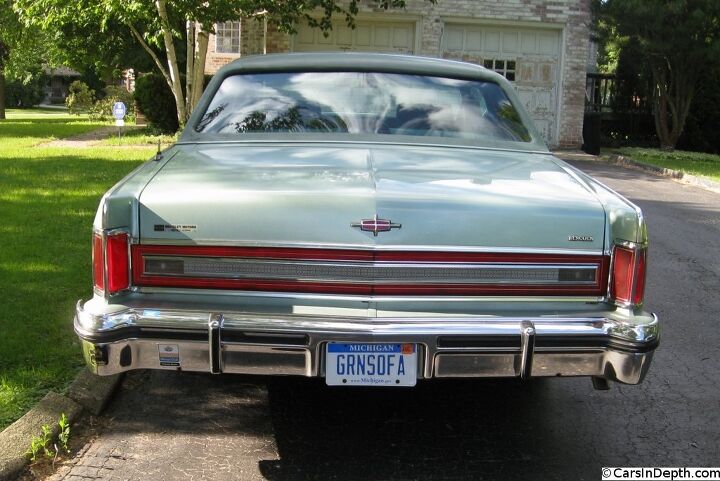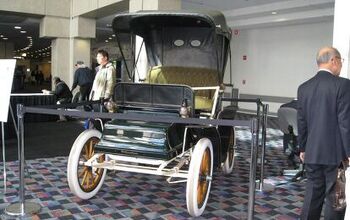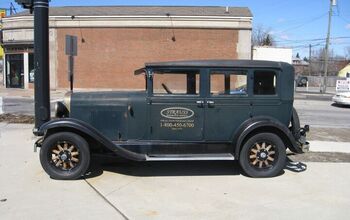Look At What I Found!: My Continental Summer

Jack Baruth called the 1976 Cadillac Fleetwood Sixty Special Talisman that he delivered to Sajeev’s brother “majestic”. While Jack and Sajeev have been playing with a big Caddy, lately I’ve been seeing a lot of Dearborn’s favorite luxury brand and it’s given me a lot of opportunity to think about Lincoln’s past and future. Today, Cadillac, buoyed by the success of the CTS and its variants, along with profitable sales of the SRX (and Escalade too) seems strong compared to Lincoln. As has been the case since Henry Leland’s day Lincoln has almost always been Detroit’s weaker sister when it’s come to luxury cars. Almost always…
While the truth is that Cadillac has always outsold Lincoln, there was a time when the two American luxury car makers went toe to toe, when Lincoln was a contender. That was the 1970s, when Lincoln started eating up some of Cadillac’s market share, when buyers who formerly would have only considered a Cadillac could be seen shopping and even buying one of Ford’s luxury cars, when that Talisman was the best that Cadillac could offer. Were it not for the success of Lincoln in the 1970s, the Panther based Town Cars so beloved of the TTAC staff might never have been built. TTAC is home to many Panther enthusiasts who will tell you that their beloved Fords are the ultimate expression of the traditional rear wheel drive body on frame big American sedan. While the Panther is worthy of all the showered love, it seems to me that if you’re looking for the ultimate big body on frame Ford, you have go back another generation, to the 1971-79 Lincoln Continental. The Panther was the first downsized full size sedan platform from Ford. It came about, in part, due to fuel mileage requirements that called for a smaller Lincoln (and LTD and Grand Marquis) and was a response to GM’s downsized ’77 sedans. So if big, bold and smooth is your ticket, the 1970s Continental is right up your alley, or suburban driveway in this case.
Though it carried on most of the styling language developed for the classic 1961 model, the classic suicide door Lincolns had unitized construction. Ford went to a separate body and frame with their big sedans in 1971. Ford was all about smoothness in the ’70s and there is nothing like BOF construction to be able to isolate the car’s passengers from the turbulence of real life. This Town Coupé’s ‘green sofa’ vanity plates sum up the car’s distinction pretty well. There has probably never been a car with a smoother ride than the big 1970s Continentals.
As with the Panthers, in the 1970s the large Fords, Mercurys and Lincolns shared variations of the same platform. The Lincoln rode on the version with the longest wheelbase, ~127″, used for both two door and four door models. We’ll be looking primarily at the two door model in this edition of LAWIF! The ’70s vintage Lincolns were the second biggest modern American cars made, exceeded in length only by the Fleetwood Cadillacs, which were about three inches longer. The notion of a two door coupé on such a long wheelbase is almost too absurd to contemplate.
LAWIF! is based on the luck of the draw. I first started thinking about doing a piece on the big Lincolns when I saw a four door in a bright yellow driving out of an apartment complex near my home. Unfortunately I didn’t have my camera rig with me but it planted the idea. Then, while riding my Litespeed to my credit union in Lathrup Village I saw the green late 1970s Continental Town Coupé you see here. Again, I didn’t have my camera bag, but I made a mental note to return and shoot the big Lincoln.
Last month, Hot Rod magazine’s Power Tour’s terminal point was in suburban Detroit, and with about 3,500 special interest cars participating, I went over to Metro Beach to see what unusual finds there were amidst the Camaros and Mustangs. When I saw this very clean and mild custom light metallic blue and black 1971 two door Continental (the ‘sportier’ Lincoln received the Town Coupé designation, a padded landau vinyl roof, large squarish opera windows, coach lights, and trim wheel arch inserts instead of full fender skirts in 1975), I knew I had to go back and get pics of the green one.
The earlier Continentals without the 5mph bumpers have a trim and tailored look for such a large car.
I decided that the following weekend, on my way to the Cars & Stars car show at the Packard Proving Grounds, I’d detour over to Lathrup. Unfortunately, just as I was about to turn into the subdivision where the Lincoln was, I saw it going out for a Sunday drive. Oh well, it would have to wait until another time.
It’s a bit of a schlep out to Shelby Twp, where the Packard Proving Grounds are, and while driving up Van Dyke, I noticed coming in the opposite direction was, yep, another big Town Coupé, this one in canary yellow. I don’t think that I’m usually worthy of getting signs from above, but this was getting silly. The first chance I got, I went back to Lathrup Village and got the pics you see here of the green Town Coupé.
From the Mark IV style chrome grille,and the big 5mph bumpers this appears to be either a ’77, ’78 or 1979 model. Over the decade, the Continental grew from 225″ to 233″, mostly due to those bumpers, though there was also a modest bump up in wheelbase. This example is in very nice original shape, with original paint that’s started to wear in only a couple of places. There’s a spot of rust near one rear wheel arch, and some of the chrome and other trim had a few dings. Other than that, it appears to be in great shape for a survivor. The original dealer’s sticker is still on the trunk lid.
Though Lincoln never seriously challenged Cadillac’s sale figures, it was in the 1970s that Lincoln started to chip away at Cadillac market share. Though it had some record sales years in the ’70s, as Jack pointed out in his piece on the Talisman by the middle of the decade Cadillac was beginning to lose its mojo, a decline that would be halted by the downsized 1977 models, only to accelerate as GM embraced mediocrity in the 1980s. In the early to mid 1970s, though, Cadillacs were beginning to seem more bloated than big. Luxury car buyers started considering first Lincoln, and then the high end Benzes.
The ’61 Continental is highly treasured today but that body style was never a big seller. While the ’61 made Continental a credible player in the mass luxury market, the next generation Continental had much better sales. Lincoln was putting a lot of effort into reducing NVH, as well as giving the cars a glass smooth ride. One of the tricks was to use rubber body mounting bushings that had a lot of fore/aft play. Though not particularly effective in terms of cornering and handling, those trick body mounts helped create the living room on wheels ride that the big Lincolns and Mercurys were famous for. A befits a rolling living room, this Continental came with crushed velour upholstery.
The association of a smooth ride with the Lincoln brand was emphasized with Lincoln even running commercials with a diamond cutter splitting a raw stone while riding in the back seat, proclaiming success with the tag line “perfect!”. The ad was so popular, and Lincoln’s reputation for a smooth ride so well known, that Saturday Night Live did a parody with a mohel performing a bris in the back seat, “Poi-fect… a beautiful baby and a beautiful car.”
Lincoln also started offering more features as standard equipment than Cadillac, like power front vent windows. The vent wing window is an artifact of the pre flow through ventilation age. It’s utility survived into the air conditioned age, and Lincoln’s power version is perhaps the ultimate development of that feature beloved of smokers and their passengers.
After the big GMs were downsized in 1977, for two years the Lincoln Continental was the biggest car for sale in the US, perhaps the biggest mass produced car for sale then in the world. Most of the big Lincolns came equipped with the 460 cubic inch version of Ford’s 429. Though it started out with 365HP, by the middle of the decade, emissions controls would cut that power output by a third. The big block engine’s torque, though, remained sufficient with 356 lb/ft @ 2,000rpm, perfectly adequate to get the two and a half ton luxury barge moving.
By the time the big Lincolns finally went out of production to make way for the Panther based Town Cars, they would be not only the largest car for sale in North America, they would have the largest displacement engines then available too (the big Cadillac 500ci V8s having been discontinued in 1976).
It just so happened that at the Hot Rod Power Tour and the Cars & Stars show there were some other classic Lincolns, a couple of prewar Continentals (a black convertible and a gorgeous yellow hardtop), and two Continental Mark IIs.
The black Mark II is an original condition, single family third generation car. The original owner was a friend of Wm Clay Ford Sr., one of his drinking buddies before he went on the wagon.
The car is no longer numbers matching because according to family lore the Mark II’s owner complained to his friend Mr. Ford, about some kind of driveability issue with the car. Apparently while he and Ford were having an extended and well lubricated lunch, Wm Clay Ford had the entire drivetrain replaced for his friend. Unlike Wm Clay Ford’s personal Mark II (in Detroit Lions’ Honolulu blue and silver), which had an upgrade to the 460 V8 performed by the fab shop in Dearborn, this car’s engine swap was not documented. It doesn’t really matter because the car will never leave the family.
After seeing those Mark IIs at the Power Tour and Cars “R” Stars, I saw even more of them when the three Ford family Mark IIs, now owned by the family that owns National Parts Depot, were on display at the Eyes On Design show benefiting the Detroit Institute of Ophthalmology.
Researching those cars led to the photo shoot of Barry Wolk’s convertible Continental Mark II. Barry has a collection of fabulous Continentals, made by Lincoln and others. He invited me to see his 1933 Lincoln when it’s on display at the upcoming Concours d’Elegance of America at St John’s and also stop by the national meet of the Lincoln Continental Owners Club, held in conjunction with the concours. Though I didn’t get over to Europe this year, it looks like I’m going to have a very continental summer.
Ford is trying to revive Lincoln. Lincoln has no brand identity, and if there is one thing that all the Continentals on this page have it’s a strong visual identity. In an era when people have difficulty distinguishing a Lexus from a Jaguar, each one of these cars is instantly identifiable, and identifiable as a Lincoln. I think the smartest thing that Ford could do is to lock its Jaguar design and brand management teams in a room with these cars and not let them out until they come up with a car that makes that same instantaneous impact, a car with the kind of visual presence all these cars have.
Ronnie Schreiber edits Cars In Depth, which features great writers and 3D to give a realistic perspective on cars and car culture. If you poke around the site there, you can see many more photos of these cars (Schreiber’s too lazy to give you the links, there’s a search function there, you’re not stupid), in 2D or your choice of 3D formats. Cars In Depth is (we’re pretty sure) the largest archive of real stereographic 3D images of real cars anywhere, with over 5,000 photos and videos and more published daily. We have what are most likely the only 3D images of some very rare cars, historic and contemporary.

Ronnie Schreiber edits Cars In Depth, the original 3D car site.
More by Ronnie Schreiber
Latest Car Reviews
Read moreLatest Product Reviews
Read moreRecent Comments
- Jalop1991 is this anything like a cheap high end German car?
- HotRod Not me personally, but yes - lower prices will dramatically increase the EV's appeal.
- Slavuta "the price isn’t terrible by current EV standards, starting at $47,200"Not terrible for a new Toyota model. But for a Vietnamese no-name, this is terrible.
- Slavuta This is catch22 for me. I would take RAV4 for the powertrain alone. And I wouldn't take it for the same thing. Engines have history of issues and transmission shifts like glass. So, the advantage over hard-working 1.5 is lost.My answer is simple - CX5. This is Japan built, excellent car which has only one shortage - the trunk space.
- Slavuta "Toyota engineers have told us that they intentionally build their powertrains with longevity in mind"Engine is exactly the area where Toyota 4cyl engines had big issues even recently. There was no longevity of any kind. They didn't break, they just consumed so much oil that it was like fueling gasoline and feeding oil every time






































































































Comments
Join the conversation
I believe that was the Mercury Grand Marquis in which the diamond was cleaved (cleaven?). I'm in agreement with the ride quality being nausea-inducing. To me, a smoothe ride is a car which follows the road and has no drama over heaves (e.g. my trusty Civic).
You may be right. I tried finding a video of the original ad but couldn't locate one. My dad had '74 Grand Marquis and it was all but a Lincoln. I remember when he bought his first set of radial Michelins for it. I had borrowed his car (I was already in college by then) and came back and told him "those Michelins really stick, I couldn't break the rear end lose". Oddly, he wasn't as pleased with the news as I was.